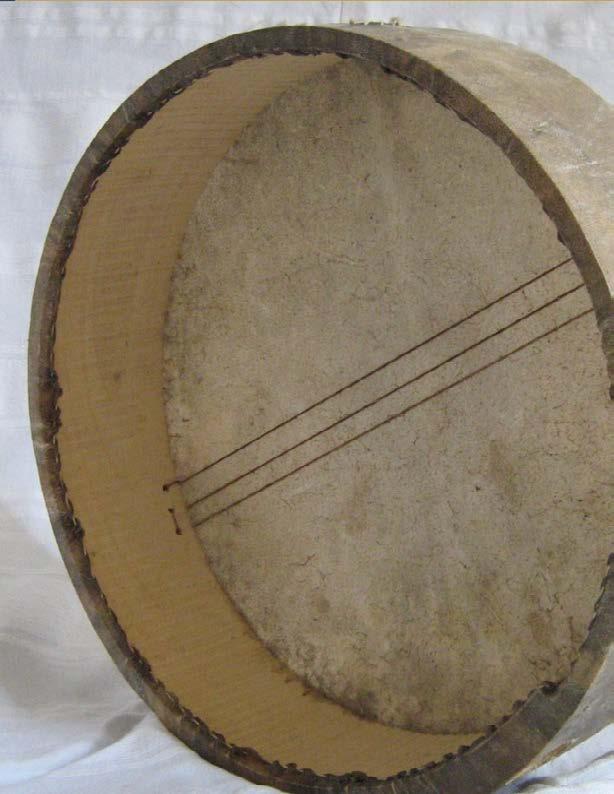
8 minute read
TIDYING UP YOUR EARLY CHILDHOOD REPERTOIRE LIST - Dr. Lisa Huisman Koops
MASTERING THE CRAFT: EARLY CHILDHOOD EDUCATION
TIDYING UP YOUR EARLY CHILDHOOD REPERTOIRE LIST
Dr. Lisa Huisman Koops
In The Life-Changing Magic of Tidying Up, professional organizer Marie Kondo (2011) advises those wishing or needing to de-clutter their lives to follow a process of gathering all the items in a category (books, clothes, papers, etc.) in one place, holding each item to check if it “sparks joy” (p. 41), and making a decision to keep or part with the item based on the joy test. Those items that are retained are stored in a systematic way, and other items are “thanked” (p. 60) and given or thrown away.
I have been teaching early childhood music classes for over fifteen years, and it is past time for me to “KonMari” (Kondo, p. 2) my repertoire pool; KonMari is a term that can be used as a verb for decluttering according to Marie Kondo’s principles. I began in 2003 with a set of 25-30 songs and chants that fit the expectations of the setting in which I was teaching at the time, and have gradually added selections until I now have closer to one hundred that I cycle through. I realized, though, that just as in the case of an over-stuffed closet, many of these one hundred songs and chant rarely get pulled out, and others do not fit anymore. In this column I will describe my process of tidying up my early childhood repertoire list with the hope that it may help others to undertake a similar process.
First, it is important for each teacher to consider the criteria by which to judge the repertoire, based on one’s teaching setting and students. I teach in an early childhood program that is based on the Music Play approach to early childhood classes (Valerio, Reynolds, Bolton, Taggart, & Gordon, 1998), so my criteria includes a repertoire set with diverse meters and modes. Many, but not all, of my songs for the youngest class (birth to age 2) are songs without words, following Music Play and Gordon’s guidelines (Gordon, 2003). With the older group (2- to 4-yearolds), I mix in songs with text.
I seek to teach the early childhood classes from a culturally responsive approach (Lind & McKoy, 2016), so this is another factor in shaping my repertoire tidying. In recent years, scholars and educators have helped the early childhood and general music communities to recognize that there are a number of songs with derogatory or painful histories and undertones that should be removed from the early childhood repertoire (Ermolaeva, 2019; Urbach, 2019; Waller-Pace et al., 2020), such as Five Little Monkeys and Camptown Races. 1 The problematic material is sometimes in the form of original lyrics that are explicitly racist and have since been changed. Some teachers have responded by saying that if they do not use the lyrics, the music is still okay. Other teachers argued that the history of the song is obscured. Some also worried that there would not be any music left to sing if we remove that which is considered offensive. The counter-arguments to these ideas include the premises that: • music is powerful and meaningful; • individuals may associate lyrics with tunes even if a teacher does not use the original words or any words; • using music with a racist or oppressive history reinforces rather than dismantles systemic racism and oppression; and • there are plenty of other songs we can use!
I have chosen to heed the call to action by removing culturally offensive and oppressive songs from my repertoire and not using those tunes without words, either. For more on the debate surrounding childhood songs and links to racism and oppression, see Ermolaeva (2019) and Urbach (2019). Engaging with the resources and the Facebook page of the non-profit organization Decolonizing the Music Room (WallerPace & Batislaong, n.d.) is another way for teachers to seek to become more culturally responsive in their teaching, a journey that moves far beyond repertoire. An additional way I seek to teach responsively is through considering the protagonists of the songs we sing. For instance, many of the songs use the pronouns “he, him, and his” for the main characters in the repertoire, including drums, dinosaurs, giraffes, and more. I have begun alternating “she, her, and hers” and “they, them and theirs” within songs that use pronouns, along with the original “he, him and his.”
Next, consider the amount of repertoire that is appropriate to your setting. Some families who participate in our program enroll for one semester, while others attend for up to three years, or even more with subsequent children. I try to have about ten songs per year that are used all year, fifteen that are used first semester and a different fifteen second semester, and additional five songs for seasons (fall, winter, spring, summer). This adds up to about sixty songs. Following that general formula, I attempt to introduce about five songs in any category that are new year to year, for those families who remain longer. My one hundred songs no longer seem like an unreasonable number, but I know there are selections that I have not used in years, and other beautiful songs yet to be discovered and introduced.
The third step is to take a repertoire list and check how it fits the criteria and the needs outlined in the first two steps. In addition to these check-points, a modified KonMari (Kondo, 2011) test can be applied: does this song or chant “spark joy” (p. 41) or meet a need for you as a teacher, for your students and their families, and for your school or organization? There are plenty of songs and chants in the world. In my opinion, our time with children is too short to work with material that is shallow or gets on our nerves. There have been excellent repertoire selections that met the context of my teaching setting that I introduced but then found to be annoying in some way. In a few other cases, a parent has mentioned how much they dislike a certain song, usually because it gets stuck in their head during class and stays there all week. As much as possible, I weed out these selections that don’t “spark joy” in favor of repertoire that does. An important parallel to this discussion is the realization that repertoire may be enjoyable for you as a teacher for a while, but then a time comes to set it aside for a few years and return to it later. If you have put certain selections away in the past because you just could not sing it one more time, this may be a good moment to consider bringing them back into the rotation.
When you have culled some of the repertoire and set it aside, it is time to find some new songs and chants. The criteria from step one may be helpful in seeking out new material. Speaking to other teachers in your school or organization, children’s families, and fellow teachers is a helpful way to learn new songs. Attending workshops and conferences is another prime way to acquire new material for the classroom. Composing your own songs, or composing with children, is a beautiful way to add meaningful repertoire to the early childhood music classroom.
Marie Kondo (2011) has specific instructions and rationale for storing and displaying the household goods and objects that one chooses to keep. For song and chant repertoire, it may also be helpful for teachers to think about how to store, organize, or display that material. Some teachers may have recordings of all repertoire and organize it in audio programs and playlists. Others might keep a shelf of songbooks with chosen repertoire marked. Kodály teachers have developed an approach to organizing and storing repertoire called a “retrieval” (https:// songretrieval.weebly.com/resource-links.html). During some years I have posted a list of favorite repertoire in the classroom as a reminder to me and the students and their families.
Taking time to pause, examine, “tidy,” and refresh our pool of repertoire is an important part of teaching. Likewise, it is vital to regularly reflect on classroom routines, broad curriculum, materials, and many other facets of teaching. I am looking forward to returning to my fall classes with a new database of repertoire lists, a sheaf of new songs and chants, and open eyes and ears for further additions to the shared musical experience with the young children and their families in our program.
REFERENCES Ermolaeva, K. (2019). Dinah, put down your horn: Blackface minstrel songs don’t belong in music class. Gen. https://gen.medium.com/ dinah-put-down-your-horn-154b8d8db12a Gordon, E. E. (2003). A music learning theory for newborn and young children. Chicago, IL: Gia Publications. Kondo, M. (2014). The life-changing magic of tidying up: The Japanese art of decluttering and organizing. Berkeley, CA: Ten Speed Press. Lind, V. R., & McKoy, C. (2016). Culturally responsive teaching in music education: From understanding to application. New York:
Routledge. Urbach, M. (2019). “You might be left with silence when you’re done”;
The White fear of taking racist songs out of music education.
Medium. https://medium.com/@martinurbach/you-might-be-leftwith-silence-when-youre-done-the-white-fear-of-taking-racistsongs-out-of-89ecdc300ee5 Valerio, W., Reynolds, A. M., Bolton, B. M., Taggart, C. C., & Gordon,
E. (1998). Music play: The early childhood music curriculum guide for parents, teachers, and caregivers. Chicago, IL: GIA
Publications. Waller-Pace, B. & Batislaong, L. (n.d.) About us: Our mission.
Decolonizing the Music Room. https://decolonizingthemusicroom. com/mission Waller-Pace, B., Batislaong, L., & McCauley, M. (2020). Making good choices: How can teachers better research repertoire for the classroom? [Professional Learning Workshop]. The NAfME Online Professional Learning Community. https://vimeo. com/419122217 Editor’s Note: This article has been adapted from the original by the author and reprinted with permission from NAfME:
Koops, L. (2019). Tidying up your early childhood repertoire list. General Music Today, 33(1), 45-46. DOI: 10.1177/1048371319863788
Dr. Lisa Huisman Koops, professor, area head, and coordinator of graduate studies in music education at Case Western Reserve University, specializes in early childhood music, general music, and world music education. She researches musical parenting and the interplay of enjoyment and agency in musical play. Koops is the author of Parenting Musically (Oxford University Press, 2020). She is the recipient of a 2017 GRAMMY Museum foundation grant for her research. Koops teaches early childhood music classes at The Music Settlement in Cleveland.





